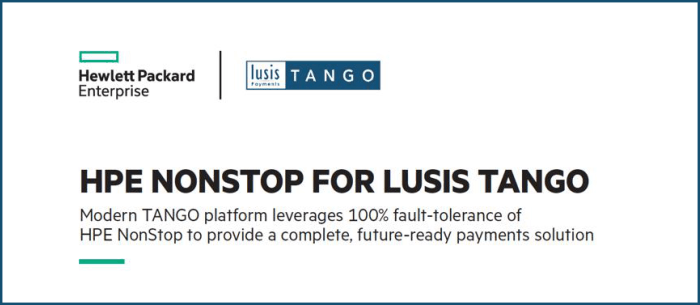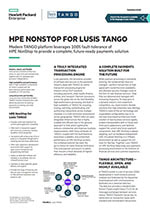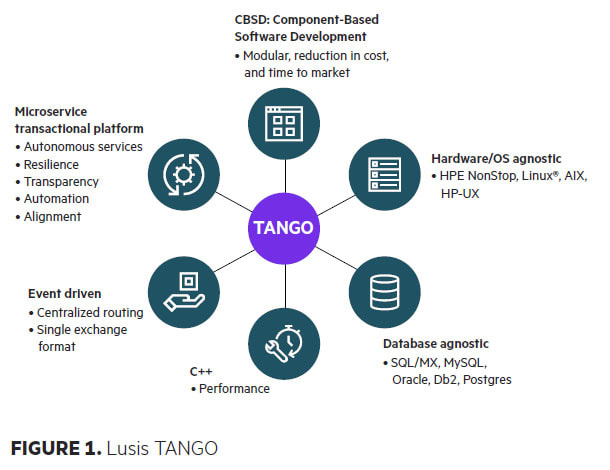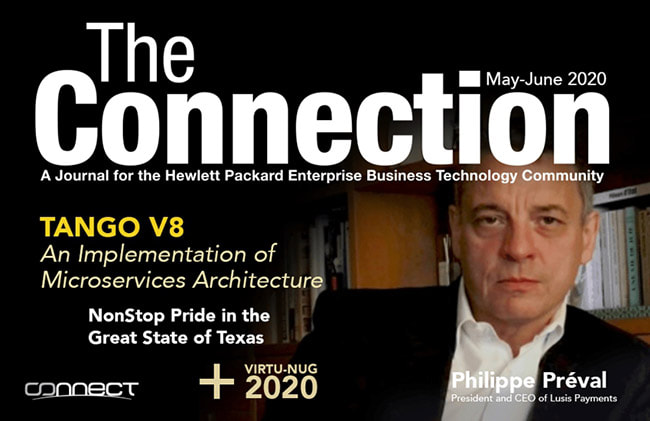|
Despite the claims of some vendors, you cannot just buy a commercially agile future out of the box. You just cannot. At Lusis Payments, our purpose is to simplify and perfect Retail Payments processing. We have been solving the world’s payments processing needs for decades using our robust TANGO software. We have earned a trusted reputation for delivering the highest quality solutions with sustained commercial agility. So, what are the ingredients of commercial agility? Embrace a Strategy of Change An organization’s true competitive advantage comes from the strength of the relationships it builds with its customers, and its ability to adapt faster than its competitors. This is a journey of continual and accelerating change. Adopting a ‘Do It Later’ policy is a fool’s errand. Everything is about learning, starting later may simply be too late! The enduring tragedy of clinging to legacy infrastructure is the insidious creepage of business constraints into the organizational processes. Ultimately, these constraining inflexibilities pollute the Corporate Thinking, be it in strategic vision, in resource investments, or in operational targets and budgets. TANGO has been developed using the principle of “Configuration Not Code”. Consequently, customers can easily adapt TANGO to leverage new partners and services. Additionally, TANGO’s microservices architecture and robust Data Bus make it the most extensible Retail payments platform available. Learning Is Everything If you are not changing your behavior, you are not learning anything. Making change an organizational habit is a team sport that has clear implications for Governance and Compliance policies. Nurturing adaptive change also has profound implications for how you architect your new solution. Most significantly, testing moves to the center stage. A strong and precisely managed testing function is a critical facilitator of change. Without advanced testing capabilities you will struggle to manage the collective risks and emotions that are an inescapable facet of change. “Experiment. Fail three out of five times. If that’s not your ratio, you’re not experimenting, but waiting for enough information to act. You can’t escape the mediocre that way.” - Temel Guzeloglu, Chief Executive Officer QNB Finansbank, Turkey Personalized Consumer Journeys Each service touchpoint is a relationship building opportunity, whether the consumer is your own customer or ‘just’ a guest. Modern consumers are becoming increasingly sophisticated and demanding in how their needs are met. If you can’t do it, they will find others who will. True loyalty is founded on earned respect - not tradition. Personalizing the consumer’s experiences is a crucial ingredient for empowering consumer trust and organizational growth. TANGO provides the ultimate in workflow flexibility including the ability to configure any combination of processing rules based on any message data elements. For example, processing services could be personalized based on card BINs, card types, merchant type, or time of day. Pick the Right Partners Choosing the right teammates to match your own vision and ethos, and agreeing how you will work together, are possibly the most important decisions you can make. Too often, organizations start their partner selection with a feature-by-feature checklist of off-the-shelf solutions. This strategy only perpetuates the status quo and fosters an inability to react to new growth opportunities. “Rethink your partners to ensure you are among partners that deliver what is needed, and readily embrace the principles of co-evolving solution journeys.” Sustained success requires a journey of continuous problem solving, where WHO you work with, and HOW you work together, has a higher impact on your successes than the fine detail of WHAT you start with. A “Pick What’s There” mindset fails because your needs will change faster than you think – because the game changes faster than you can predict. Lusis’ customers enjoy long term benefits from TANGO as a result of its superior technology, and from Lusis’ decades of experience in delivering and supporting advanced Retail payments solution. A TRULY INTEGRATED TRANSACTION PROCESSING ENGINE Lusis payments, the innovative provider of software and services to the payments industry, leads with TANGO, an online transaction processing engine for mission-critical 24x7 solutions including payments, retail, loyalty, finance, utilities, and transport. Payment processors across the globe rely on the total flexibility, high-performance processing, and built-in high availability of TANGO for acquiring, routing, switching, authenticating, and authorizing transactions across multiple channels, in a multi-institution environment across geographies. TANGO offers an open, integrated infrastructure that is highly scalable and efficient due to the genuine approach to SOA, which significantly reduces complexities and improves business responsiveness. With these attributes of TANGO, coupled with the fault-tolerance, near-linear scalability, and unmatched performance of HPE NonStop systems, the combined solution has been the go-to choice for many financial institutions (FIs) and payment processors to satisfy their mission-critical demands of highest efficiency and reliability. A COMPLETE PAYMENTS SOLUTION BUILT FOR THE FUTURE While payment processing is constantly evolving, the fundamentals have not changed—perform transactions at high speed with round-the-clock availability and absolute security. Changes come in the form of new financial services—how they are delivered and managed with increasing frequency. To keep pace in a dynamic industry and outperform competitors, you need modern, flexible solutions that help streamline new offerings. TANGO’s state-of-the-art technology and unparalleled configurability due to its microservices-based architecture foster creation of new business services rapidly, enable interoperability with in-house and third-party applications, and facilitate support for current and future payment components. And HPE NonStop is always adapting, such as hardware-independent HPE Virtualized NonStop in a VMware environment as well as support for rich tools for DevOps. Together, Lusis TANGO on HPE NonStop helps keep your payments processing environment at the forefront of financial services and customer experience. TANGO ARCHITECTURE—FLEXIBLE, OPEN, AND HIGHLY AVAILABLE A TANGO system is a set of services (SOA) implemented in multi-instance process modules and federated by the dispatcher (load-balancer) with communications facilitated via a universal data bus. The data bus provides a standard data format (Type/Length/Value [TLV]) for all messages exchanged between services. Hence, TANGO Payments Server has no restrictions on transaction types: both standard and nonstandard transactions can be easily defined in the system, as can new transaction types and message flows. This flexibility easily accommodates new requirements and integration of new payment opportunities including external services for fintech APIs. TANGO’s specialized high-availability components integrated within the platform provide an active/active systems integration without the need for third-party solutions. The active/active support within TANGO allows any given terminal to connect to any of the application servers to provide 24x7 availability to customers. And to further the advantages, TANGO’s architecture deeply integrates with some of the modern and core fundamentals of HPE NonStop such as use of OSS and TMF-protected SQL/MX database, and full exploitation of HPE NonStop “process pair” feature through its hypervisor process. The dispatcher functionality works together with HPE NonStop TS/MP to provide scalability and availability, and supports the active/active configuration. This further establishes HPE NonStop as one of the most ideal platforms to run your TANGO payments solution. READ THE ENTIRE ARTICLE
This article is an introduction to TANGO version 8, a major upgrade that provides full microservice integration and complete Cloud capacities. Introduction
Our broadly used Tango software is an implementation of a microservice architecture. Tango was not initially designed to be “microservice”, it was more properly designed to implement a transactional, mission critical, Service Oriented Architecture “that works” (SOATW!). By “that works” I mean, performant, scalable, avoiding contentions and anarchic leeway and sustainable. It is clear that to make it sustainable, a SOA system must include major concepts: a data bus or universal messaging layer to anarchy (meaning the ability to define as many interfaces than relations between services) and a load-balancer in order to avoid contentions or stress points. Some state that these 2 concepts are the key differences between SOA and microservice. However, the definition of microservice is not so clear and sometimes it is nothing more than: “it is not a monolithic architecture”. So, the first thing we will do is define it, then we will outline what applies and what does not apply in Tango and finally we will present Tango v8. What is a microservice architecture? A microservice application is a collection of autonomous services, each of them doing one thing well, and when combined, work together to provide a global service. Instead of a single complex system (monolithic architecture), the aim is to build and manage a set of relatively simple services that might interact in complex ways. These services collaborate with each other through a messaging protocol. The idea is quite simple. Having a collection of little ships instead of a huge one. That metaphor is not totally wrong. Lots of little ships are easy to maneuver, if one is delayed the others can progress. However, you can quickly cover more space with your multiple ships and if one is sunk (bad feature, bad design…) the others can still fight. Of course, there are some intrinsic difficulties: first a light fleet requires more coordination, second it is not as easy to make it a robust battleship. Anyway, microservices promise a better way to sustainably deliver business impact. Rather than a single monolithic unit, applications built using microservices are made up of loosely coupled, autonomous services. Building services that do one thing well avoids the inertia and entropy of large applications. Properties of microservices are:
Microservices applications scale by:
Five architectural principles structure microservices developments:
As mentioned above there are specific challenges and risks:
Tango. What we implement, what we do not. First, we at Lusis produce mission critical systems or applications that can’t fail. They must never lose a single transaction, never lose an order, never tolerate an outage, etc… This is not the standard world of the “web apps”. This is such an important difference that only those who are in the mission critical business can really understand it because failure of these mission critical systems could be the deciding factor between a managing director keeping their job or not. As with Lusis Tango, the HPE Nonstop was built on this same concept/mantra. Every component within the Nonstop framework is designed to never allow failure. Which is the reason why the HPE Nonstop has been the preferred hardware platform of choice for many large banks and financial institutions as well as other mission critical businesses for many years. Lusis Tango runs successfully on the HPE Nonstop. Lusis Payments has several customers realizing huge performance advantages running Lusis Tango on the HPE Nonstop. In addition, our systems are highly scalable and available which is imperative in the mission critical environment. Second, we are not realizing apps, projects or custom development. We are designing and developing a software that has to be economically competitive. This means for instance, that all development must look like the others, be written in the same way, with the same style, as we can’t afford “specialist developer” for this work. This is close to the CBSD model of development that I won’t expound upon here but to say it is fundamental in our development approach. Third, we provide an IT infrastructure that will last for many years into the future. So, it must be designed to live and scale, change, and mutate for 10, to 20 years or more. The infinity of an IT time scale. Therefore, we have some very specific requirements:
Having said that, a Tango application is clearly a collection of autonomous services, each of them doing one (or a few more) thing(s) well, that work together to provide a global service. They can be developed separately and deployed and run independently. A Tango application scales properly along the 3 axes that were mentioned above. As we are providing software in a restricted number of business spaces these services can be grouped in “families of services” that are doing the same kind of things at a conceptual level. It is important because each “family” or sub-family, have its own technique and set of libraries, tools, and ways to improve productivity. For instance, in a payment system, services types are:
The studying of the Susan Fowler’s book Production-Ready Microservices was very useful to us as it allowed us to review and audit our Tango architecture from the criteria for Production Readiness that she defines. The review concluded that a strong majority of these criteria were met (95%). When we were observing that Tango was not matching one of those criteria it was either by mistake or by a decision. In that case, it was worthwhile to evaluate if this decision was still valid. For instance, we were not interested in implementing the capacity for a Tango application to auto-create instances of services if the software was indicating there were not enough of them. For this reason: as we could not push the wall, or create CPU unit, it was useless or even negative to create new instances that would have further disturbed the machine and worsened the situation. Of course, this is no longer true with the Cloud capacities. From this review we deducted a list of Tango architecture features that constituted the base of the Tango Version 8 roadmap. Tango Version 8 We will limit the presentation to the two most important changes that are creating a true disruption considering Cloud capacity. Reviewing the “dispatcher” As mentioned above the Tango dispatcher oversees the technical routing and load-balancing. This is a very robust, very efficient (microseconds to process), multi-instanced service. However, mixing these two functionalities has some drawbacks: the routing context is in the dispatcher (timeout, multi-step rule, …), the dispatcher uses Tango events like a normal Tango service and therefore ,the dispatcher is not context free so can’t be easily “cloudified”. The dispatcher will be split into two parts:
When a Tango service sends an event (either a request or a notification), the destination is computed by applying the routing rules on the message. There are two cases:
When the destination service is local, the event is directly sent to the service using direct COM (a Tango process that knows each service composing it and can push directly the events inside a specific instance of a specific service), otherwise the message will be sent to the message router. The message router will not be a “Tango service”, it will use a lightweight Tango process and exchange messages using an optimized binary protocol not using standard Tango messaging. A typical event routing message will contain information about the sender, the target and the content. The message router will be completely agnostic about the message content, it will only use the routing data for delivery. The message router gathers the list of connected services all the services are connecting to all message routers and keep the connection alive like is done with the dispatcher using the self-registering feature and when an event must be routed it will choose the “best matching target”. Publish/Subscribe pattern has also been added for outgoing notifications:
Microservice self-monitoring This covers two new functionalities: ‘custom counters’ and ‘process/service auto-spawn’. Custom counters can be defined to monitor the processing time for specific events (usually only the request/response/notifications are monitored regardless of the kind of message). Now, a reference time can be defined for the event processing considered as a “normal” processing time for this kind of message for this microservice (ex: order creation on the OMS service). Processing time is computed in real-time and when the service begins to get “overwhelmed”. If the processing time increases over a defined limit, then alerts will be triggered and logged allowing the system to monitor the problem as soon as it occurs and locate the failure directly. Sometimes, the processing time may increase because the load is getting higher than usual (load peak) so the custom counters can also be linked to the “auto-spawn” feature. If defined inside the configuration, Tango will spawn automatically new instances of the microservice or process whenever the load is going over the predefined limit, allowing the Tango environment to automatically scale in function of the load. A new microservice will also be added gathering processing times and health status from all the other microservices, allowing centralized monitoring and provide real-time health status information about the environment to a dashboard. Full Cloud capabilities In conclusion:
Bibliography: Microservices – Microservices in action by Morgan Bruce, Paulo Pereira Microservices – Production-Ready Microservices by Susan J. Fowler CBSD – An Introduction to Component-Based Software Development by Kung-Kiu Lau, Simone di Cola Scalability – The Art of Scalability by Martin L. Abbott, Michael T. Fisher |
lUSIS nEWSThe latest company and industry news from Lusis Payments. Archives
June 2024
Categories
All
|






 RSS Feed
RSS Feed